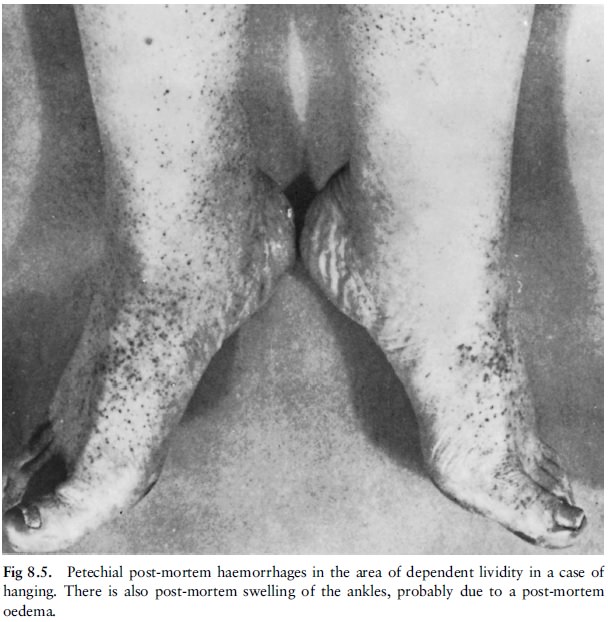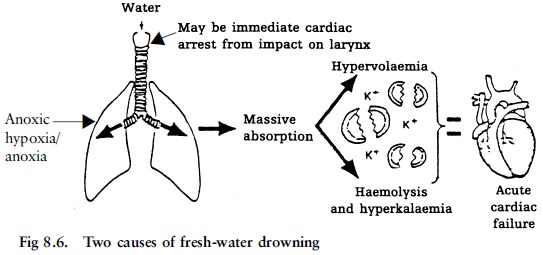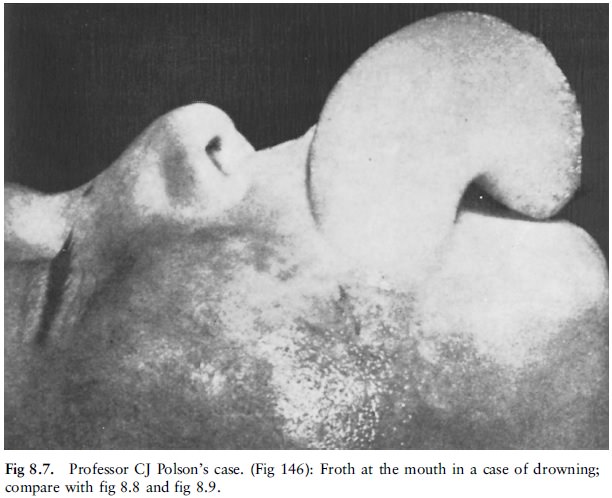Chapter: Forensic Medicine: Asphyxia
Causes of asphyxic death: Drowning
Drowning
If a body is retrieved from water (submersed
bodies) the death could be due to:
1)
natural causes (eg myocardial infarct) before falling into the water; in
other words the person suffered a heart attack, died and then fell into the
water
2)
natural causes (eg heart attack) while in the water
3)
unnatural causes (eg gunshot wound) before falling into the water
4)
unnatural causes (eg multiple injuries after being hit by a boat or
bitten by a shark) while in the water
5)
the effects of submersion other than drowning
6)
drowning
The situations sketched in (1) to (4) are also
known as pseudo-drowning. The person may have died of natural or unnatural
causes while outside the water, and then fallen into the water, or these causes
may occur in the water. The most common natural cause is a myocardial infarct or
heart attack. Certain natural conditions, such as epilepsy can predispose a
person to drowning. It is often difficult to distinguish between ante- and
post-mortem wounds, as the blood is washed from the body and the wounds appear
clean.
Signs of submersion
1)
Maceration of the skin. This condition develops rapidly in warm water,
but may take hours to develop in cold water. This skin is pale and wrinkled,
the so-called ``washer-woman's skin'', similar to what it looks like after
lying in the bath for a long period. Maceration appears first in areas with a
thick keratin layer, such as the fingertips, palms and toes (photo 5). After
days in warm water and weeks in cold water the sogged keratin layers become
detached, but they can still be used to identify the deceased (eg finger
prints), as the small skin grooves are preserved.
2)
Cutis anserina. This condition is non-specific. The skin looks
like goose flesh, as the small muscles of the hair follicles contract making
the hairs stand up. This can also be observed in other types of death.
3)
Distribution of post-mortem hypostasis. In still water a body will float on its abdomen
with the limbs facing downwards. The post-mortem colour changes or lividity
will be present over the legs, arms and the ventral (anterior) aspect of the
abdomen. With much water movement the body is constantly rolled around, causing
more widespread and uniform distribution. The hypostasis is often a pink
colour.
4)
Foreign material in airways and upper
gastro-intestinal system. Sand, mud, crustaceans and plants are often present in the airways and
oesophagus, especially if the body was rolled around vigorously or the water
was very deep.
5)
Partial breaking of rigor mortis. Rigor mortis can be broken by the wave
movement. However, this will only be partial, as only certain muscle groups
will be involved.
Determination of the period of submersion
Water temperature is the most important factor
determining the appearance of the body. Water pollution per se plays a minor
role, although the temperature of sewage water could rise due to bacterial
activity.
The following can be used as guideline to the duration of submersion:

The two groups of death where the death is a
direct result of the submersion, with or without aspiration of water or other
liquid medium, will now be discussed.
Drowning without the aspiration of fluid into the lungs
Some deaths occur without aspiration of water.
Possible causes are:
1)
Acute neurogenic cardiac arrest. Sometimes a person dies
instantly when hitting the water, probably from acute neurogenic cardiac
arrest. A possible cause may be the sudden stimulation of the skin or the back
of the throat by cold water. Alcohol can predispose a person to this condition
because it dilates the blood vessels of the skin.
This condition, also known as hydrocussion, is
often witnessed in harbours when intoxicated sailors fall into the sea, and die
instantly, even before the bodies can be taken out of the water.
2)
Hypothermia. The effect of cold water and subsequent
hypothermia is discussed in study unit 10.
3)
Laryngospasm. We have already said that irritation due to the
inhaled water will cause a spasm of the vocal cords (laryngospasm). This will
then prevent airflow, as well as further aspiration of water, into the lungs.
It is not clear whether laryngospasm alone can cause death. Usually it will
disappear when the person loses consciousness due to the hypoxia, but he will
then aspirate in the unconscious state, and die.
4)
Drowning with breathing apparatus. Divers can die of many causes, such as
defective diving gear (leading to suffocation due to hypoxia), carbon dioxide
poisoning, decompression disease, nitrogen poisoning (depth-ecstasy), and
pulmonary barotrauma (with or without air-embolism). It is important that a
diving expert inspect the diving gear, preferably while it is still attached to
the body.
Drowning with the aspiration of fluid into the lungs
This refers to the general concept of drowning,
where the person inhales water and dies.
The following pathophysiological conditions may
play a role:
1)
Hypoxic hypoxia/anoxia. It is obvious that in a medium devoid of air,
such as water, the human being is not able to absorb oxygen, which then results
in hypoxia/anoxia.
2)
Fluid and electrolyte disturbances. When water is inhaled, rapid absorption through
the large and highly permeable surface area of the alveoli of the lungs occurs.
Salt water and fresh water have different effects: salt water has the same salt
content as blood and is therefore not absorbed so rapidly into the blood, and
also does not change the salt content of the blood.
Fresh water is absorbed rapidly and in large
volumes by the alveoli. Dilution of the blood occurs (because the salt content
of fresh water is lower than that of blood), causing haemodilution, which
decreases the haemoglobin level, and leads to anaemia. At the same time the
blood volume increases, which results in hypervolaemia of the circulation. Due
to the lower salt content of the blood, the red blood cells will swell and burst.
The potassium in the cells is released, leading to an increased potassium level
(hyperkalaemia). This affects the heart negatively, causing cardiac arrest.
In salt water drownings these severe fluid and
electrolyte disturbances do not occur. People therefore survive longer in the
sea than in fresh water.
Post-mortem signs
The post-mortem signs depend on the post-mortem interval, because some of the signs of drowning, such as foam in the airways, will disappear with time.
1)
Foam in airways. Due to the mixing of protein, surfactant (a lung
secretion to decrease the surface tension in the alveoli) and the inhaled
water, a thick foam is produced, which can exude as a plume from the nose. It
has a whitish-pink appearance. However, this is not a specific feature, as it
can also be seen in conditions such as heart failure and other deaths (fig 8.5,
8.6 and 8.7).



2)
Lung changes. The lungs can exhibit different appearances:
a)
Pulmonary oedema. In this case the inhaled water is present in the
lungs and the lungs are typically heavy and congested. With dissection, fluid
will drain freely from the surface.
b)
``Dry lung'' drowning. In these cases pulmonary oedema is absent. This
is not an uncommon event and is present in 10 to 20% of drownings. It is most
probably caused by complete absorption of all the inhaled water by the lungs,
before the person dies from fluid and electrolyte disturbances.
c)
Over-inflation of lungs (emphysema aquasum). This is a common condition and is often seen in
association with oedema. The oedematous fluid prevents deflation of the lung,
and there is often also over-inflation due to the valve-like effect of the
secretions in the lung.
d)
Haemorrhages in lungs. Haemorrhages may occur in the lung tissue or
below the pleural surface (subpleural). This is most probably caused by extreme
attempts to inhale.
3)
Haemorrhage in the middle ear. Although some authors believe that haemorrhages
in the middle ear are a clear indication of drowning, it is an unreliable sign.
It is most probably the result of pressure of the water on the middle ear.
4)
Stomach content. The presence of water in the stomach is
unreliable as a sign of drowning; pressure of the water on the submersed body
is sufficient to force water into the stomach.
5)
Cataleptic stiffening or cadaver spasm. This phenomenon was discussed in depth in study
unit 3. It is an indication that the person was alive when falling into the
water.
6)
Post-mortem trauma. Propellers of boats and ships, as well as shells
and rocks can cause injury to the submerged body. It is often difficult to
differentiate between ante- and post-mortem trauma.
Tests
Special tests may be performed in cases of
drowning.
1.
Test to determine biochemical changes.
Biochemical changes occur when water is inhaled.
The chloride concentration of the blood from the left and right ventricles is
compared. In a case of drowning in fresh water, the haemodilution effect will
lower the chloride concentration as the blood circulates through the lungs (ie
the level of chloride in the left ventricle will be lower than that in the
right ventricle). In the case of drowning in seawater, the opposite will occur.
However, in practice this does not always happen and the test should therefore
be interpreted with caution.
2.
Test to find diatoms in lung tissue .
Diatoms are microscopically small silica-like
organisms which occur freely in nature. It is believed that isolation of a specific
type of diatom in the lung tissue, blood and bone-marrow of a deceased person
confirms that the person drowned in a specific body of water. However, diatoms
are freely found in a number of substances (including toothpaste), and because
of this, as well as the fact that isolating them from tissue is so
timeconsuming, this test has become obsolete.
It is important to remember that a finding of
drowning is often made on circumstantial evidence obtained during the inquest.
It is also important to remember that an
individual could be rescued and revived, only to die at a later stage due to
lung complications (especially the inhalation of water) or brain damage. This
is called secondary or near-drowning. Cases have been described where children
had been submerged in ice-cold water for some time, but after resuscitation and
warming up, survived with no or little brain damage. This is due to the
protective effect of hypothermia on the brain, as it decreases the oxygen
requirements of the brain.
Related Topics